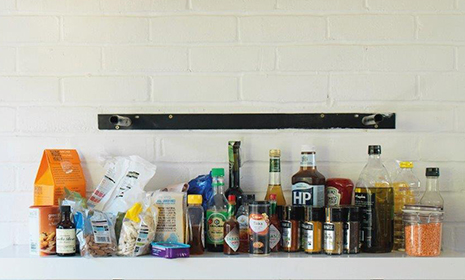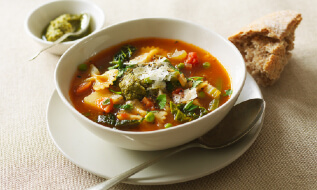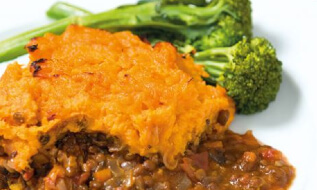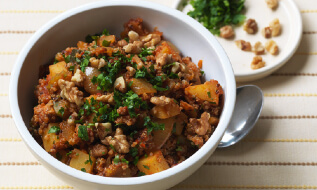
Having a few staple ingredients in your store cupboard helps whip up nutritious meals in minutes.
A store cupboard is the starting point for a lot of meals and can save you time, effort and money. Having a good supply of basics like tins of tomatoes or beans will come in handy for many recipes.
In this article we’ll explain how to have a well-organised store cupboard, ready to make tasty, nutritious homemade meals.
Easy store cupboard recipes
These quick and easy meals can be created in minutes with ingredients from your store cupboard.
Minestrone soup

If you have a low salt stock cube, a handful of pasta shapes, a tin of tomatoes, a teaspoon of dried herbs and an onion you almost have a hearty minestrone. Just add a mixture of 500g of vegetables. You can use anything from carrots, mushrooms and cabbage to frozen peas and tinned sweetcorn. You can even add lettuce. It’s great for clearing out the fridge and the veg rack and getting more vegetables in your diet.
Try our hearty minestrone soup recipe.
Biryani
With basmati rice (or brown rice works well) an onion, a low salt stock cube and some curry powder or paste, you’re well on the way to a tasty biryani. You can then just add fresh, tinned or frozen vegetables, frozen prawns or leftover cooked chicken.
Give our chicken biryani a try.
Clafoutis
You can also easily put together your own clafoutis. This is a baked French dessert featuring a thick batter over fruit. For a really versatile and quick pudding you just need flour (try using wholemeal), eggs, vegetable oil or spread, baking powder, sweetener (if you like) and milk, plus some fresh fruit such as apple or pear, or tinned or dried fruit. Just put the fruit into an ovenproof dish, mix the rest of the ingredients together, pour over the fruit and bake.
Try our other easy dessert recipes.
Things to remember when organising your store cupboard
- Choose a cupboard furthest away from the oven or hob as the heat will speed up deterioration of most foods.
- Airtight containers preserve the shelf life of everything from herbs and spices to flour, nuts and seeds. You don’t need expensive containers, recycled jam jars are excellent, just remember to label them.
- Check the dates on labels and if something is nearing its best-before date then bring it to the front of the cupboard to remind you to use it.
- Have a spring clean. Check the dates on packets and tins, remove everything from the cupboard and clean it out occasionally. Stale particles of flour, grain, cereals, sugar and crumbs at the bottom of the cupboard can attract pests.
Basic store cupboard essentials
These products are key to any kitchen and will come in handy for multiple recipes.
Tinned fish
A tin of salmon or tuna can be transformed into a meal, used in fishcakes or just mixed with a can of beans or chickpeas, a finely chopped onion and a little olive oil, lemon juice or vinegar to create a super salad. Add chopped peppers, tomatoes and cucumber and you have a healthy meal in seconds. Make sure to check for added salt. Some fish is tinned in brine, and those in olive oil or water may also have added salt. Why not try tinned mackerel or sardines too? They’re a great way to add more oily fish to your diet, which is full of healthy omega-3 fatty acids.
Find out more about a healthy, balanced diet for diabetes.
Tinned chickpeas, beans and lentils

Chickpeas can be used to make a tasty hummus or a quick curry with just the addition of an onion, some curry paste and a blob of yogurt or a couple of tomatoes.
You could also roughly mash them and add finely chopped sautéed onion and garlic along with a teaspoon of ground cumin or curry powder. Mix with a beaten egg, form into golf-ball-sized patties and fry in a teaspoon of olive oil for a delicious falafel.
There are lots of different pulses available – kidney beans make a great addition to chilli, or use them to replace some or all of the meat like we have in our mixed bean chilli recipe.
Lentils are very versatile and make a great vegetarian shepherd’s pie.
Remember you can buy either tinned or dried versions of beans and pulses. Dried versions take longer to cook and may need to be soaked. Beans, peas and lentils are also very high in fibre and don’t affect your blood glucose levels too much.
Try our vegetarian shepherd’s pie with sweet potato mash recipe.
Tinned tomatoes
You can rustle up your own pasta sauce quickly and easily with tinned tomatoes as the main ingredient. Simply add a heaped tsp of dried herbs, a crushed garlic clove (or garlic granules) and a pinch of chilli flakes and you have a basic tomato sauce. You can use this for pizza or pasta. Just add some chopped onion, peppers, courgettes or mushrooms and toss through any pasta shape or top any pizza base.
Flour and dried fruit
You can use flour and dried fruit to make lots of different breads, desserts and cakes which are also ideal for using up spices, such as cinnamon and mixed spice. You can also add leftover dried fruit such as apricots, prunes and raisins, or seeds and nuts. For a quick soda bread just mix together wholemeal flour, bicarbonate of soda or baking powder, water and chopped dried fruit. Dried fruit also makes a great topping on porridge, or yogurt.
Find out more about baking and diabetes.
Grains

We usually think of rice as a staple for partnering with curries, chilli or stews. But lots of different types of grains have a great shelf life and can become part of your store cupboard.
Grains such as couscous, quinoa and buckwheat can make a good alternative to white rice and are higher in fibre. This is great news for digestive health and helping to manage your blood glucose and cholesterol levels.
Our recipe for Andean-style quinoa uses some store cupboard ingredients, with added fresh veg. Try any combination of veg you have and mix up the flavourings for some variety.
Tinned fruit and veg
You don’t have to have fresh fruit and veg to gain all the beneficial nutrients. Tinned or frozen are just as good and last longer. Keeping tinned fruit (in juice) in the cupboard can come in handy for a quick snack or dessert with some natural yogurt and help you towards your five a day. Look out for tins with no added sugar or salt. Fruit is best tinned in natural juice (you can drain this away).
Nuts and seeds
A great snack, plain nuts and seeds can also be added to your breakfast, used in baking and as a useful source of protein and healthy unsaturated fats. Because they contain a lot of fat they shouldn’t be kept for long periods. If nuts show any signs of mould they can be toxic so should be thrown out.
Try our almond, apricot and pumpkin seed granola.
Herbs and spices
We should all be trying to eat less salt. Too much salt is linked to high blood pressure which increases the risk of heart problems. Having some herbs and spices in your store cupboard can help you add instant flavour to meals. Keep them in air tight containers to maintain freshness and also choose low salt stock cubes.
What’s the difference between ‘use by’ dates and ‘best before’ dates?
‘Use by’ dates are put on fresh foods and foods past their ‘use by’ date may be unsafe to eat. ‘Use by’ dates do not always mean you have to eat the food by that date.
For example, if the food can be frozen, then you can extend its life beyond the ‘use by’ date. If you decide to do this, it’s extremely important that you follow the instructions on the pack, such as whether or not it needs to be fully defrosted before cooking.
‘Best before’ dates are for guidance. You can still safely eat foods past their ‘best before’ date but they may not be at their best quality.
For instance, spices could lose some of their flavour, so you may need to add more to get the same intensity of flavour. Avoid eggs past their ‘best before’ date as they may contain more salmonella after this date.
